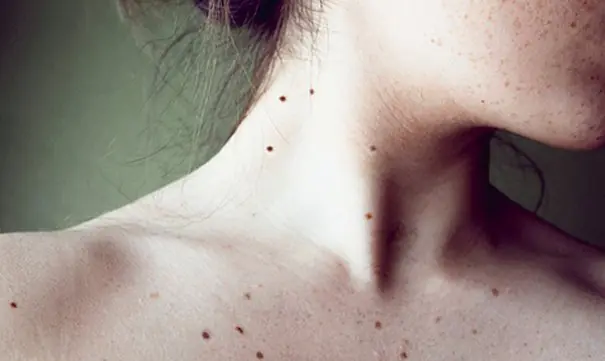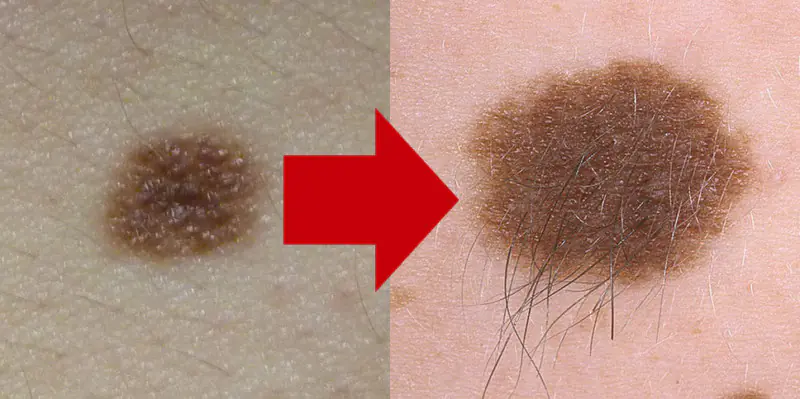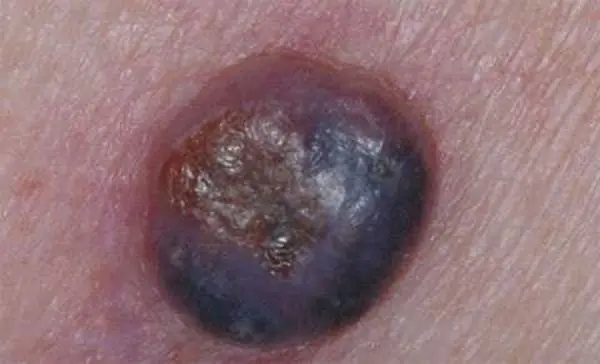During pregnancy, the female body undergoes many changes. One of the changes is the appearance of moles, which can worry a woman. Most often, there is no reason for concern, since nevi are formed due to hormonal changes in the body. But sometimes this can be due to other circumstances and can be dangerous. Therefore, it is worth finding out why such formations appear, and in what cases it is advisable to consult a doctor.
Reasons for appearance
The appearance of moles is usually associated with increased exposure to ultraviolet radiation on the skin. Another reason is hormonal imbalance. They can also form under the influence of age-related changes, for example, during adolescence. During this period, the production of individual hormones begins, which leads to the formation of nevi.

Pregnancy causes many changes in the body. One of them is a change in hormonal levels. This is why pregnant women develop moles.
After the birth of a child, the hormonal system returns to its normal state, due to which many neoplasms are eliminated. Although they may remain, and this is also a variant of the norm. If there are no adverse symptoms, there is no reason for alarm.
Danger
Since the formation of moles during pregnancy is a natural phenomenon, they do not pose any danger. In most cases, they resolve themselves after the birth of the child. But even if this does not happen, in the absence of pathological symptoms there is no danger. Moles are benign neoplasms, so there is no need to worry about their presence on the skin.
But a woman should consult a doctor to make sure there are no risks. Sometimes nevi have the ability to become malignant. Since a pregnant woman’s body is weakened, there is a possibility of exacerbation of any pathologies. If there is a predisposition to cancer, then they can begin to develop during pregnancy, and the appearance of nevi becomes one of the first symptoms.
Also, the degeneration of benign formations can begin due to injury or exposure to ultraviolet radiation.
You should consult a doctor under the following circumstances: strange color of a mole or its unexpected change, itching in the area of the nevus, burning, swelling of the skin, bleeding of the neoplasm.
It is also worth consulting with a specialist if too many moles form.
Increase in size
Although new moles during pregnancy are not dangerous, some caution is required. It is necessary to pay attention to emerging negative symptoms. One of them is increasing size. This may be a sign of infection or degeneration into a malignant tumor. In this case, you need to observe not only new growths, but also those that were on the body before.

If the mole has increased in size, you need to talk to your doctor and get examined. It is especially important to do this if there are additional adverse symptoms, such as pain, itching, bleeding.
Unfavorable symptoms do not always indicate disease. The growth of a nevus or a change in its color can be explained by hormonal changes in the body. But sometimes these changes trigger an oncogenic process, which can be very dangerous. Therefore, you should undergo an examination.
Preventive measures
The formation of a nevus during gestation is considered normal. But under the influence of unfavorable factors, problems may arise. Therefore, it is worth taking precautions.
These include:
- Protecting the tumor from sunlight. Exposure to ultraviolet radiation can cause cells to degenerate into a malignant tumor. And since a pregnant woman’s immunity is weakened, the risk increases. Therefore, moles on the body should be covered with clothing. You should also refrain from visiting the solarium and sunbathing.
- Prevention of injury. If the integrity of a mole is damaged, an infection may enter the bloodstream. The inflammatory process can cause growth in the size of the tumor and its degeneration into a malignant tumor. Therefore, it is necessary to prevent mechanical damage to the surface.

Areas of skin where there are nevi should not be scratched. This can lead to injury and infection. If the formation itches, you need to be examined. The appearance of fluid in the tissue of a mole is also a cause for concern. It is unacceptable to squeeze it out.
Is deletion allowed?
Removing moles during pregnancy is not advisable. This is explained by the fact that some of them may disappear after stabilization of hormonal levels. This is also due to the unpredictability of the consequences of any intervention in the body. If in normal conditions recovery after surgery to remove a nevus occurs easily, then the expectant mother may experience problems. It is also unknown how such exposure will affect the child.
However, such procedures during gestation are not prohibited. Mole removal is carried out using minimally invasive methods that have almost no effect on the body. During the manipulation, local anesthetics are used, which are considered safe. Therefore, there are no direct contraindications for intervention, and skin growths can be removed.
In some cases, mole removal is necessary. The procedure may be prescribed under the following circumstances: the likelihood of trauma to the tumor, the location of the nevus in the perineal area, a high risk of degeneration into a cancerous tumor.
These situations pose a risk to the health of both the woman and the child. Therefore, it is better to remove the tumor. But the decision about this must be made by the doctor, having assessed the features of the clinical picture.
The formation of moles during gestation is a common phenomenon. Due to the lack of knowledge on this issue, women began to come up with their own explanations for this process. Most of them have not been scientifically confirmed, but are still popular among the population.
Such myths include:
- If, while carrying a child, a mole forms on the body of the expectant mother, then the baby will also have one, and in the same area. There is no evidence to support this opinion. Most children emerge with clear skin without any growths. They begin to form by adolescence, and their location can be any. Although, if there is a genetic predisposition, a similar outcome is possible, and if the mother had many moles, they may appear in the child.
- Based on the location of the nevi, predictions can be made regarding the fate of the mother and baby. This myth is also not confirmed. There is no relationship between skin spots and life events.
- A pregnant woman can cause nevi to appear on the baby's body. This is supposedly possible if, in severe fright, she grabs some part of her body. According to myth, the baby will form a birthmark in this place. But this assumption is wrong. Expectant mothers should not worry about this; in their condition, it is harmful to worry.
Moles on the body are a harmless phenomenon, even if they form in a pregnant woman. This is due to changes in hormonal levels. When it returns to normal, most of the tumors will disappear. Those nevi that remain are also not dangerous if they are not accompanied by pathological symptoms. Removing moles during pregnancy is rarely practiced if there is a threat to the health of the mother and baby.
Expectant mothers often notice the appearance of new moles on their bodies during pregnancy. This phenomenon is quite common; in most cases, moles begin to appear and grow in the second trimester. The fact is that at this time women experience a hormonal surge, which provokes the appearance of tumors. This phenomenon raises a lot of questions among women, because the appearance of new moles is considered by many to be a bad sign.

What is important to know about moles?
It should be noted that there is a direct connection between the appearance of new moles and hormonal disorders. The fact is that moles often form during periods when hormonal changes occur in the body. First you need to understand what a mole is. Small dark areas of skin are a group of cells with a high content of melanocytes - particles that are responsible for pigmentation. For some people, moles appear right at birth, while for others they form during life.
Moles or, in other words, nevi, can have a different appearance. They may differ in color and size. In addition, there are smooth moles, rough and convex ones. In some cases, hair grows on the surface of the nevus. You should not be afraid of such varieties; these are all variants of the norm that do not pose any danger.
Pregnancy is different for all women. Some experience all the features of this situation at once, while others do not notice at all that their well-being has changed in any way. Some women develop new moles on their bodies during pregnancy. There is no need to worry about this, since this is as normal as toxicosis.
Is it possible to remove moles for pregnant women?
Despite the relative harmlessness of moles, there is still a risk of serious illness. According to statistics, in one case out of 100,000, the spread of moles is not random, but indicates the development of cancer - melanoma. This disease can lead to death. In order not to risk your health, you need to monitor changes in your moles.
If a specialist diagnoses a precancerous condition of skin cells, the mole will be removed, however, this can be done after the birth of the child. If the case turns out to be critical and the mole needs to be removed immediately, the pregnant woman will be asked to sign special documents, according to which she will be warned about the possible risk to pregnancy, after which the mole will be surgically removed.
How is mole removal done during pregnancy?
If, after a thorough diagnosis, the specialist still decides that the mole needs to be removed, do not immediately panic. Today's surgical capabilities make it possible to remove a mole quickly and painlessly, and this is usually done under local anesthesia. Today you can get rid of tumors on the body in several ways:

- method of surgical excision of a mole;
- using a laser;
- using cryotherapy - liquid nitrogen and low temperatures;
- radio wave therapy method;
- electrocoagulation - in this case, the mole is affected by high frequencies.
The most suitable option for pregnant women is to remove the nevus using a laser. This option suits almost everyone. There are only a few exceptions. If the mole must be removed immediately, it will be removed surgically. Only excision can remove the entire affected area.
The advantage of laser removal is that this procedure is absolutely painless and is performed without the use of anesthesia. The method of surgical excision is usually used in the most extreme cases, when there is confirmed information about the presence of malignant cells.
It is worth noting that removing moles on your own or seeking help from healers can lead to adverse consequences. If there are malignant cells in the mole, they must be completely removed. In addition, after removal, the specialist conducts additional research and prescribes treatment. You should not risk your health; it is better to turn to professionals.
What's important to remember?
- You should avoid prolonged exposure to the sun and visiting a solarium.
- If during pregnancy the skin begins to peel and itch, you should choose a good moisturizing soap.
- Moles that are located in areas potentially subject to mechanical stress should be monitored.
- Follow your doctor's recommendations and be sure to take vitamins.
You shouldn’t worry too much about moles during pregnancy, but you shouldn’t completely forget about them. Their condition should be checked from time to time, and if suspicious phenomena appear, it is better to immediately consult a doctor.
Video: which moles are dangerous to health
The appearance of new moles on the body of expectant mothers is not uncommon. They do not always decorate the face and body. Therefore, pregnant women often wonder whether they can be removed immediately. Should this be done during pregnancy or should I wait until the baby is born?
Moles and pregnancy
Such neoplasms on the body occur during periods of greatest activity of the hormonal system. The connection between moles and hormones is direct. And since at the beginning of bearing a baby, a woman’s body completely rebuilds its work, the balance of hormones also changes, and nevi appear on the skin. They are a cluster of skin cells overflowing with melanocytes, that is, dark pigments.
Nevi come in different shades depending on the amount of pigment accumulated in them. Sometimes they are dark brown, sometimes light brown, black. The surface of neoplasms can be uneven, rough, and convex. Sometimes hairs may stick out from a mole. All of these are variants of the norm. This is not dangerous for a woman if the tumor does not increase in size. Pregnant women should not be afraid of the appearance of moles in any area of the body. It often happens that after childbirth they disappear on their own.
About the removal of nevi in pregnant women
If an old mole in an expectant mother suddenly begins to change its shape, then you should contact an experienced dermatologist. But in most cases, this is not a big deal, just like the appearance of new ones on the body. They do not affect the course of pregnancy. But there are always exceptions to the rules. In one case out of a hundred thousand, a mole can degenerate into melanoma - a malignant neoplasm. If the dermatologist discovers that the nevus cells are in a precancerous state, then it will need to be removed. But this must be done after the baby is born. In rare cases, dermatologists offer to solve the problem immediately, without delay. And you shouldn’t be afraid of this. This procedure is performed under local anesthesia and is painless. Today, the level of medicine makes it possible to remove unwanted moles with a laser, using cryotherapy (cauterization with extreme cold or liquid nitrogen), electrocoagulation (exposure to high-frequency current), traditional surgery, or a radioknife. As for expectant mothers, they are recommended to remove nevi with a laser. This method of dealing with moles has almost no contraindications and is suitable for most. An experienced doctor will adequately assess the condition of the mole and give advice on caring for the area of the body where it is located.
Surgical excision of nevi is performed in expectant mothers in rare cases. This is done only after a positive conclusion from the oncologist.
As for removing moles during pregnancy purely for aesthetic reasons, this should not be done. It is impossible for appearance in such a crucial period to be more important than the psychological comfort of the unborn baby. It is strictly forbidden to remove moles on the body during pregnancy on your own. Carelessness and carelessness can lead to irreversible consequences. During this important period, you should also not seek help from traditional healers to remove tumors.
To prevent them from degenerating from benign to malignant, it is necessary to limit the time spent under the influence of direct sunlight. It is prohibited to visit a solarium while pregnant. Such recommendations also apply to the period of breastfeeding.
Sometimes during pregnancy, a woman’s skin becomes drier, flaky, and itchy. Then you need to choose a good moisturizer to care for it. You should not allow the growths to be scratched or vigorously rubbed after taking a shower. If a mole is localized in an area of high friction, then you need to be especially careful with it.
And ordinary people, and especially expectant mothers, should always carefully monitor whether the nevus changes size and shape. Many dermatologists are confident that vitamin deficiency and the appearance of new nevi on the body of expectant mothers are closely related. Therefore, taking the prescribed multivitamins will not be superfluous.



